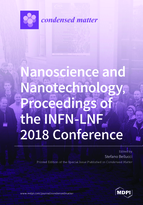Nanoscience and Nanotechnology, Proceedings of the INFN-LNF 2018 Conference
A special issue of Condensed Matter (ISSN 2410-3896).
Deadline for manuscript submissions: closed (31 January 2019) | Viewed by 24364
Special Issue Editor
Interests: carbon nanotube; materials science & nanotechnology; multifunctional materials; nanocarbon; biomedical applications
Special Issues, Collections and Topics in MDPI journals
Special Issue Information
Dear Colleagues,
The NEXT Nanotechnology group at INFN—Laboratori Nazionali di Frascati (LNF) has since 2000 organized a series of international meetings in the area of nanotechnology. The 2018 conference is devoted to recent developments in nanoscience and their manifold technological applications. These consist of a number of tutorial/keynote lectures, as well as research talks presenting frontier nanoscience research developments and innovative nanotechnologies in the areas of biology, medicine, aerospace, optoelectronics, energy, materials and characterizations, low-dimensional nanostructures and devices. We plan to submit selected papers based on conference talks and related discussions for publication in a dedicated issue entitled “Nanoscience and Nanotechnology Letters. Invited Lectures and selected talks from the 2018 Conference”. Papers will be published after careful refereeing process. A second issue will handle contributions on similar topics not presented at the conference.
Dr. Stefano Bellucci
Guest Editor
Manuscript Submission Information
Manuscripts should be submitted online at www.mdpi.com by registering and logging in to this website. Once you are registered, click here to go to the submission form. Manuscripts can be submitted until the deadline. All submissions that pass pre-check are peer-reviewed. Accepted papers will be published continuously in the journal (as soon as accepted) and will be listed together on the special issue website. Research articles, review articles as well as short communications are invited. For planned papers, a title and short abstract (about 100 words) can be sent to the Editorial Office for announcement on this website.
Submitted manuscripts should not have been published previously, nor be under consideration for publication elsewhere (except conference proceedings papers). All manuscripts are thoroughly refereed through a single-blind peer-review process. A guide for authors and other relevant information for submission of manuscripts is available on the Instructions for Authors page. Condensed Matter is an international peer-reviewed open access quarterly journal published by MDPI.
Please visit the Instructions for Authors page before submitting a manuscript. The Article Processing Charge (APC) for publication in this open access journal is 1600 CHF (Swiss Francs). Submitted papers should be well formatted and use good English. Authors may use MDPI's English editing service prior to publication or during author revisions.
Keywords
- Nanotechnological applications of manoscience for the applicative areas of biology
- medicine
- aerospace
- optoelectronics
- energy
- materials and characterizations
- low-dimensional nanostructures and devices






